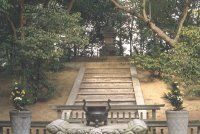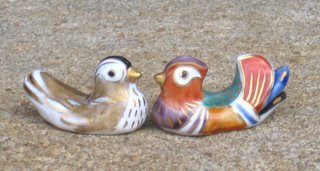:::::::::::::::::::::::::::::::::::::::::::::::::::::::::::::::::::::::::::::::::::::::::::::::::::::
Spirits of Wood
Tokyo National Museum shows Buddhist masterpieces
「仏像 一木にこめられた祈り」
Shaping Faith ― Japanese Ichiboku Buddhist Statues
*Read the Original here, with photos*
(c) The Japan Times, Nov. 9, 2006
http://search.japantimes.co.jp/mail/fa20061109a2.html
Living in a land still largely covered with forest, it is not surprising that Japanese have a special reverence toward wood. We see this particularly in traditional architecture, where wood is not only chosen to reveal its best qualities, but is largely left unpainted so that its beauty improves
with use and age.
*Ichiboku *-- carving from a single block of wood -- is thought to have developed in Japan under the instruction of the Chinese priest Jian Zhen (688-763) during the production of numerous images for the Toshodaiji Temple in Nara Prefecture. Ichiboku carving soon replaced the bronze, earthenware and lacquer that had been used to make earlier religious statues, and it became the dominant process for the manufacture of Buddhist images until the middle of the Heian Period (794-1185).
*"Shaping Faith,"* an exhibition of ichiboku carving at the Tokyo National Museum Heisei-kan, displays the finest examples of the art form from the seventh until the 19th century, borrowed from temples around Japan. Most are of Bodhisattvas or various guardian deities who are usually trampling on some grimacing demon who dared to challenge Buddhist teachings.
The Japanese have believed since ancient times, as part of the Shinto religion, that spirits and gods are housed in trees and timber, as they are in all things. Looking at the fine examples shown in the first part of this exhibition, it seems that the divinity of the image is underscored with the power inherent in the material itself.
The earliest example is a small statue of the 11-Headed Kannon -- a Bodhisattva or enlightened deity -- that chooses to remain on Earth to help mortals on their own path to enlightenment, and symbolizes wisdom and compassion. It was finely carved from a block of tropical sandalwood and brought to Japan from Chang-An (present-day Xi'an), the capital of Tang-Dynasty China, by a member of a religious exchange mission.

東京国立博物館蔵. Tokyo National Museum
Sandalwood was treasured for its fragrance and its dense, close grain, which makes it most suitable for detailed carving. The statue's face shows very Indian-looking features with large, hooded eyes and a prominent nose, and was modeled on statues brought to China from the subcontinent by Buddhist priests. Many similar images were subsequently made in the Nara area with gradually larger dimensions and faces that became more and more Japanese in appearance. There were almost no local supplies of sandalwood, so native camphor, and later *kaya *(Japanese yew) and other dense-grained woods, were used instead.
One Buddha from the Todaiji Temple in Nara is portrayed in one of his manifestations as the Miroku Nyorai -- the "Buddha of the Future." This seated image wears the simple robe of a monk and has the double-crowned head of tight curls that we associate with the enlightened. His face, however, is otherworldly, quite unlike that of any human, and reflects his special status as a messiah-like deity scheduled to return to Earth in the distant future to save any leftover sentient beings that haven't, by that time, achieved enlightenment.
During the Heian Period, an extraordinary sculptural departure from standard techniques appeared in areas remote at the time from the capital, such as the present-day prefectures of Toyama and Aichi. Many statues from these rural temples are characterized by having been finished with *natabori* -- chiseled, repeated hatchet marks -- horizontally aligned over the surface of the finished image. Apart from being strangely modern in appearance, an uncanny, lifelike effect is caused by the changing light as it falls on the multiple marks.
One of these hatchet-carved statues represents the Zen Priest Houshi, (Baozhi from China, circa 418-514), who is famed for his powers of transformation; his face is split vertically to reveal the emerging Kannon Bodhisattva. This is a truly haunting image, testimony to the deep faith, rich imagination and artistic skill of 11th-century woodcarvers and, by itself, more than worth a visit. (Photo see below.)
The last part of the exhibition is devoted to the works of the much later, Edo Period carvers, Enku (1632-95) and Mokujiki (1718-1810) that show a complete departure from any other religious imagery. The period saw the appearance of eccentric creativity in painting and calligraphy, perhaps inspired and protected by the vibrant merchant culture that was eclipsing that of the courtiers, warlords and samurai. With this background in mind it is easier to understand the emergence of these two unusual sculptors.

岐阜・高賀神社蔵 Enku Statues
Enku traveled around the mountainous areas of central Japan as a pilgrim or wandering ascetic, carving for temples in exchange for food and lodging. His images were roughly hewn from whatever wood was available -- often splitting a log into three vertical sections to form the basic shape of each statue.
Much of his carving approaches the abstract, with form being defined by rough ax strokes, and facial features of eyes, nose and mouth merely hinted at with hatchet marks. The details of hands and feet were often ignored, and all are executed in plain, unfinished wood.
Enku's works make no effort to hide that they are born of poverty. Yet they reflect a powerful spirituality on a human scale that simple rural folk would feel and understand.
*Mokujiki,* too, was a wandering hermit, but his works are markedly different from those of Enku in being clearly carved and well-finished. His sculptures are unique for the variety of faces he employed for depicting various deities, each rounded in shape, large-eyed, and mostly smiling or grimacing. The aloof serenity that we normally associate with Buddhist images is abandoned here for much more human expression. Though smoothly polished, the broad chisel marks are evident and devoid of surface color or gilding so that one feels their essential "woodiness."
An outstanding group of 33 figures from the Kokuriyama Mokujiki Kannondo Temple in Niigata show the large, central Nyoirin Kannon surrounded by smaller manifestations of the same deity. All have such expressive, almost cartoonlike faces that they might lead us to ponder where the roots of modern-day *anime* might lie.

新潟・小栗山木喰観音堂蔵. Mokujiki
All the images shown are of Buddhist figures -- except for a 10th-century statue of a seated male deity from the Futagami Imizu Shrine in Toyama Prefecture. This figure from the ancient, native Shinto pantheon exudes that profound respect for nature's mysteries so close to raditional Japanese rice-growing society -- and acutely felt even today.
No wonder *matsuri* festivals are still boisterously celebrated all over Japan to invoke the benevolence of myriad local deities. The Japanese well sense the power and life force of trees that seem to be imbued in these statues, underscoring the teachings that they symbolize.
www.butsuzo.jp
Look at more photos here !
(c) The Japan Times, Nov. 9, 2006
******************************************************
*Daruma Museum, Enku and Mokujiki Buddha Statues*
:::::::::::::::::::::::::::::::::::::::::::::::::::::::::::::::::::::::::::::::::::::::::::::::::::::
宝誌和尚立像 Priest Hooshi

平安時代・11世紀/像高159cm
京都・西住寺 . 重要文化財
:::::::::::::::::::::::::::::::::::::::::::::::::::::::::::::::::::::::::::::::::::::::::::::::::::::
first winter wind -
warm smiling Buddha
merciful hands
First winter wind greeting from Japan
Etsuko Yanagibori
:::::::::::::::::::::::::::::::::::::::::::::::::::::::::::::::::::::::::::::::::::::::::::::::::::::
仏教を信仰した国の中で、日本ほど木で仏像を造ることにこだわった国はありません。
飛鳥時代から奈良時代にかけて、日本の仏像は金銅仏や乾漆像、塑像が主流でした。しかし、奈良時代後半頃から一本の木材からできるだけ像の主要部分を造り出す一木彫が盛んに造立されるようになると、それ以降、日本では仏像の大半が木で造られるようになります。本展では、日本人がこだわった木で仏像を造ることの意味を考えるとともに、そこで培われた良質な木の文化を通して日本人の心や精神性に触れます。
展覧会は、「檀像の世界」、「一木彫の世紀」、「鉈彫」、「円空と木喰」という四つのテーマを通して、その底流に脈々と流れる日本人が木と仏に託した祈りの世界を浮かび上がらせます。
出品作品は146体でいずれも名品揃い。特に会期の後半(11月7日~12月3日)に展示される滋賀・向源寺の国宝十一面観音菩薩立像(渡岸寺観音堂所在)は今回、寺外初公開の作品です。その姿の美しさから白洲正子、井上靖、土門拳、水上勉ら多くの人々の心を魅了してきた像として知られています。ぜひ仏像が作り出す平和で静謐な世界をご期待下さい。
特別展 仏像 一木とは 木彫像の中で、一本の木で造られた技法の像を一木彫(いちぼくちょう)と呼びます。多くが仏教彫刻の場合において用いられます。一木造は頭部や体部の主な部分を通して一本の木から彫り出す技法ですが、その内容には幅があります。頭部と体部の主な部分のみを一木から造り、その他の部分(両肩から先、坐像ならば脚部など)は別に造っているものから、手、本体から遊離する天衣の部分、さらに台座の一部までを本体と同じ一木から彫り出すものまであります。
また、頭髪や体部などの一部に木屎漆(こくそうるし)(漆に小麦粉を混ぜた麦漆に木粉や植物繊維を加えて練ったもの)を用いるものもあり、表面の仕上げも白木のままとするもの、彩色を施すもの、漆箔(しっぱく)を施すものなど様々です。
一木彫の場合、最も問題となるのは、干割れが生じやすいということです。使用される木材には、あらかじめ木の心(木心、年輪の中心部分)を外しているものと木心を含んでいるものとがありますが、後者の場合は特に干割れの危険性が高いです。
それを解消するために行われるのが内刳りです。内刳りとは、通常は像の背面から、(坐像の場合はさらに像の底からも刳りを施して木心を除去することをいいます。)干割れ防止の他にも、像の軽量化を図れるという効果があります。ただし、像によっては像内に木心があっても内刳りが施されていない場合もあり、それを行うか行わないかは素材の特性を見極めながら判断されていたようです。
一木彫の造形は、木の表面から内側に彫り進むことによって決定されるために、一度削ったら修正は不可能です。結果的に、細部の破綻が全体に及ぶ危険性があり、制作者は常に細部から全体へ、全体から細部へと目を配りながら仕事を進めていく必要があります。つまり、制作者と素材である木には常に緊張関係にあり、そこには、一刀、一刀精神をこめて彫り進む真剣勝負の世界が展開していたに違いありません。一木彫の中に、時代を超えて現代の人々の心を揺さぶる名品が多いのは、こうしたことに起因しているといえるのではないでしょうか。
© http://event.yomiuri.co.jp/2006/butsuzo/about.htm
:::::::::::::::::::::::::::::::::::::::::::::::::::::::::::::::::::::::::::::::::::::::::::::::::::::
[ . BACK to WORLDKIGO . TOP . ]
[ . BACK to DARUMA MUSEUM TOP . ]
:::::::::::::::::::::::::::::::::::::::::::::::::::::::::::::::::::::::::::::::::::::::::::::::::::::














